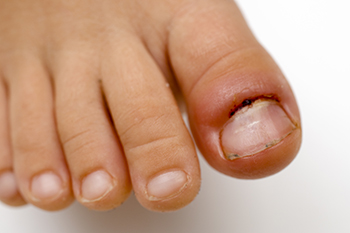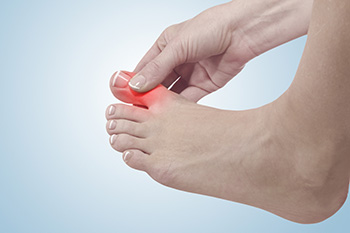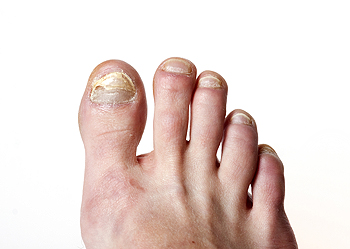Items filtered by date: March 2025
Signs and Causes of Toe Infections

A toe infection can cause pain, swelling, redness, and discharge, making daily activities difficult to complete. Common causes of toe infections include fungal infections like athlete’s foot or toenail fungus, bacterial infections from cuts or injuries, and ingrown toenails. Fungal infections thrive in warm, moist environments and can spread through shared surfaces or personal items. Bacterial infections often develop when bacteria enter the skin through small breaks, such as improperly trimmed nails or blisters. People with diabetes or circulation problems are at a higher risk, as they may not feel early symptoms, which allows infections to get worse. Signs of a more serious infection include fever, warmth surrounding the toe, or red streaks moving up the foot. Without treatment, an infection can spread to deeper tissues, increasing the risk of serious complications. A podiatrist can diagnose the cause of your infected toe, clean the affected area, and recommend the appropriate treatment. Antifungal medication, antibiotics, or minor procedures to remove infected tissue are among the options. If you believe your toe has become infected, it is suggested that you schedule an appointment with a podiatrist for an exam, diagnosis, and treatment.
Toe pain can disrupt your daily activities. If you have any concerns, contact one of our podiatrists of Advanced Ankle & Foot Surgeons. Our doctors can provide the care you need to keep you pain-free and on your feet.
What Causes Toe Pain?
Most severe toe pain is caused due to a sports injury, trauma from dropping something heavy on the toe, or bumping into something rigid. Other problems can develop over time for various reasons.
Toe pain can be caused by one or more ailments. The most common include:
- Trauma
- Sports injury
- Wearing shoes that are too tight
- Arthritis
- Gout
- Corns and calluses
- Hammertoe
- Bunions
- Blisters
- Ingrown toenails
- Sprains
- Fractures (broken bones)
- Dislocations
When to See a Podiatrist
- Severe pain
- Persistent pain that lasts more than a week
- Signs of infection
- Continued swelling
- Pain that prevents walking
Diagnosis
In many cases the cause of toe pain is obvious, but in others, a podiatrist may want to use more advanced methods to determine the problem. These can range from simple visual inspections and sensation tests to X-rays and MRI scans. Prior medical history, family medical history, and any recent physical traumatic events will all be taken into consideration for a proper diagnosis.
Treatment
Treatments for toe pain and injuries vary and may include shoe inserts, padding, taping, medicines, injections, and in some cases, surgery. If you believe that you have broken a toe, please see a podiatrist as soon as possible.
If you have any questions please feel free to contact our office located in O'Fallon, and New Baden, IL . We offer the newest diagnostic tools and technology to treat your foot and ankle needs.
Signs and Causes of Toe Infections

A toe infection can cause pain, swelling, redness, and discharge, making daily activities difficult to complete. Common causes of toe infections include fungal infections like athlete’s foot or toenail fungus, bacterial infections from cuts or injuries, and ingrown toenails. Fungal infections thrive in warm, moist environments and can spread through shared surfaces or personal items. Bacterial infections often develop when bacteria enter the skin through small breaks, such as improperly trimmed nails or blisters. People with diabetes or circulation problems are at a higher risk, as they may not feel early symptoms, which allows infections to get worse. Signs of a more serious infection include fever, warmth surrounding the toe, or red streaks moving up the foot. Without treatment, an infection can spread to deeper tissues, increasing the risk of serious complications. A podiatrist can diagnose the cause of your infected toe, clean the affected area, and recommend the appropriate treatment. Antifungal medication, antibiotics, or minor procedures to remove infected tissue are among the options. If you believe your toe has become infected, it is suggested that you schedule an appointment with a podiatrist for an exam, diagnosis, and treatment.
Toe pain can disrupt your daily activities. If you have any concerns, contact one of our podiatrists of Advanced Ankle & Foot Surgeons. Our doctors can provide the care you need to keep you pain-free and on your feet.
What Causes Toe Pain?
Most severe toe pain is caused due to a sports injury, trauma from dropping something heavy on the toe, or bumping into something rigid. Other problems can develop over time for various reasons.
Toe pain can be caused by one or more ailments. The most common include:
- Trauma
- Sports injury
- Wearing shoes that are too tight
- Arthritis
- Gout
- Corns and calluses
- Hammertoe
- Bunions
- Blisters
- Ingrown toenails
- Sprains
- Fractures (broken bones)
- Dislocations
When to See a Podiatrist
- Severe pain
- Persistent pain that lasts more than a week
- Signs of infection
- Continued swelling
- Pain that prevents walking
Diagnosis
In many cases the cause of toe pain is obvious, but in others, a podiatrist may want to use more advanced methods to determine the problem. These can range from simple visual inspections and sensation tests to X-rays and MRI scans. Prior medical history, family medical history, and any recent physical traumatic events will all be taken into consideration for a proper diagnosis.
Treatment
Treatments for toe pain and injuries vary and may include shoe inserts, padding, taping, medicines, injections, and in some cases, surgery. If you believe that you have broken a toe, please see a podiatrist as soon as possible.
If you have any questions please feel free to contact our office located in O'Fallon, IL . We offer the newest diagnostic tools and technology to treat your foot and ankle needs.
How to Manage Gout

Gout is a type of arthritis that occurs when uric acid builds up in the body, forming crystals in the joints. It commonly affects the big toe but can also impact other joints. The symptoms include intense, sudden pain, swelling, redness, and heat, often beginning at night. The pain can be so severe that even the weight of a blanket can feel unbearable. Gout is more common in men over 40 and women after menopause due to hormonal changes and higher levels of uric acid in the body. Other risk factors include a diet high in purines found in red meat and seafood, alcohol consumption, obesity, and certain medications. A podiatrist can help diagnose gout by examining your foot and performing tests to detect uric acid crystals. Treatment often involves anti-inflammatory medications, pain relievers, and lifestyle changes, such as diet modifications and weight management. If you have this condition, it is suggested that you schedule an appointment with a podiatrist for proper care and management.
Gout is a painful condition that can be treated. If you are seeking treatment, contact one of our podiatrists from Advanced Ankle & Foot Surgeons. Our doctors will treat your foot and ankle needs.
What Is Gout?
Gout is a form of arthritis that is characterized by sudden, severe attacks of pain, redness, and tenderness in the joints. The condition usually affects the joint at the base of the big toe. A gout attack can occur at any random time, such as the middle of the night while you are asleep.
Symptoms
- Intense Joint Pain - Usually around the large joint of your big toe, and it most severe within the first four to twelve hours
- Lingering Discomfort - Joint discomfort may last from a few days to a few weeks
- Inflammation and Redness -Affected joints may become swollen, tender, warm and red
- Limited Range of Motion - May experience a decrease in joint mobility
Risk Factors
- Genetics - If family members have gout, you’re more likely to have it
- Medications - Diuretic medications can raise uric acid levels
- Gender/Age - Gout is more common in men until the age of 60. It is believed that estrogen protects women until that point
- Diet - Eating red meat and shellfish increases your risk
- Alcohol - Having more than two alcoholic drinks per day increases your risk
- Obesity - Obese people are at a higher risk for gout
Prior to visiting your podiatrist to receive treatment for gout, there are a few things you should do beforehand. If you have gout you should write down your symptoms--including when they started and how often you experience them, important medical information you may have, and any questions you may have. Writing down these three things will help your podiatrist in assessing your specific situation so that he or she may provide the best route of treatment for you.
If you have any questions, please feel free to contact our office located in O'Fallon, and New Baden, IL . We offer the newest diagnostic and treatment technologies for all your foot care needs.
How to Manage Gout

Gout is a type of arthritis that occurs when uric acid builds up in the body, forming crystals in the joints. It commonly affects the big toe but can also impact other joints. The symptoms include intense, sudden pain, swelling, redness, and heat, often beginning at night. The pain can be so severe that even the weight of a blanket can feel unbearable. Gout is more common in men over 40 and women after menopause due to hormonal changes and higher levels of uric acid in the body. Other risk factors include a diet high in purines found in red meat and seafood, alcohol consumption, obesity, and certain medications. A podiatrist can help diagnose gout by examining your foot and performing tests to detect uric acid crystals. Treatment often involves anti-inflammatory medications, pain relievers, and lifestyle changes, such as diet modifications and weight management. If you have this condition, it is suggested that you schedule an appointment with a podiatrist for proper care and management.
Gout is a painful condition that can be treated. If you are seeking treatment, contact one of our podiatrists from Advanced Ankle & Foot Surgeons. Our doctors will treat your foot and ankle needs.
What Is Gout?
Gout is a form of arthritis that is characterized by sudden, severe attacks of pain, redness, and tenderness in the joints. The condition usually affects the joint at the base of the big toe. A gout attack can occur at any random time, such as the middle of the night while you are asleep.
Symptoms
- Intense Joint Pain - Usually around the large joint of your big toe, and it most severe within the first four to twelve hours
- Lingering Discomfort - Joint discomfort may last from a few days to a few weeks
- Inflammation and Redness -Affected joints may become swollen, tender, warm and red
- Limited Range of Motion - May experience a decrease in joint mobility
Risk Factors
- Genetics - If family members have gout, you’re more likely to have it
- Medications - Diuretic medications can raise uric acid levels
- Gender/Age - Gout is more common in men until the age of 60. It is believed that estrogen protects women until that point
- Diet - Eating red meat and shellfish increases your risk
- Alcohol - Having more than two alcoholic drinks per day increases your risk
- Obesity - Obese people are at a higher risk for gout
Prior to visiting your podiatrist to receive treatment for gout, there are a few things you should do beforehand. If you have gout you should write down your symptoms--including when they started and how often you experience them, important medical information you may have, and any questions you may have. Writing down these three things will help your podiatrist in assessing your specific situation so that he or she may provide the best route of treatment for you.
If you have any questions, please feel free to contact our office located in O'Fallon, IL . We offer the newest diagnostic and treatment technologies for all your foot care needs.
Symptoms and Testing for Foot Drop

Foot drop occurs when patients find it difficult to lift the front portion of their foot, resulting in dragging or slapping of the foot while walking. Known as steppage gait, this walking pattern involves raising the leg higher than usual to prevent the toes from catching on the ground. Foot drop may affect one or both feet, causing sensations of tingling, numbness, or weakness in the ankle, toes, or top of the foot. Several conditions can cause foot drop, including peripheral neuropathy, muscular dystrophy, nerve injury, diabetes, and neurological issues like stroke or multiple sclerosis. A podiatrist can assess symptoms through a physical examination, checking for muscle weakness or loss of function, and by performing nerve conduction studies, ultrasounds, or imaging tests to rule out other causes. Treatment of foot drop often involves nerve stimulation, or wearing braces or orthotics to support proper foot positioning. In some cases, surgery may be needed to repair nerve damage or reposition tendons. If you have trouble lifting your feet when walking, it is suggested that you schedule an appointment with a podiatrist for an exam, diagnosis, and treatment.
If you have any concerns about your feet, contact one of our podiatrists from Advanced Ankle & Foot Surgeons. Our doctors can provide the care you need to keep you pain-free and on your feet.
Biomechanics in Podiatry
Podiatric biomechanics is a particular sector of specialty podiatry with licensed practitioners who are trained to diagnose and treat conditions affecting the foot, ankle and lower leg. Biomechanics deals with the forces that act against the body, causing an interference with the biological structures. It focuses on the movement of the ankle, the foot and the forces that interact with them.
A History of Biomechanics
- Biomechanics dates back to the BC era in Egypt where evidence of professional foot care has been recorded.
- In 1974, biomechanics gained a higher profile from the studies of Merton Root, who claimed that by changing or controlling the forces between the ankle and the foot, corrections or conditions could be implemented to gain strength and coordination in the area.
Modern technological improvements are based on past theories and therapeutic processes that provide a better understanding of podiatric concepts for biomechanics. Computers can provide accurate information about the forces and patterns of the feet and lower legs.
Understanding biomechanics of the feet can help improve and eliminate pain, stopping further stress to the foot.
If you have any questions please feel free to contact our office located in O'Fallon, and New Baden, IL . We offer the newest diagnostic and treatment technologies for all your foot and ankle needs.
Symptoms and Testing for Foot Drop

Foot drop occurs when patients find it difficult to lift the front portion of their foot, resulting in dragging or slapping of the foot while walking. Known as steppage gait, this walking pattern involves raising the leg higher than usual to prevent the toes from catching on the ground. Foot drop may affect one or both feet, causing sensations of tingling, numbness, or weakness in the ankle, toes, or top of the foot. Several conditions can cause foot drop, including peripheral neuropathy, muscular dystrophy, nerve injury, diabetes, and neurological issues like stroke or multiple sclerosis. A podiatrist can assess symptoms through a physical examination, checking for muscle weakness or loss of function, and by performing nerve conduction studies, ultrasounds, or imaging tests to rule out other causes. Treatment of foot drop often involves nerve stimulation, or wearing braces or orthotics to support proper foot positioning. In some cases, surgery may be needed to repair nerve damage or reposition tendons. If you have trouble lifting your feet when walking, it is suggested that you schedule an appointment with a podiatrist for an exam, diagnosis, and treatment.
If you have any concerns about your feet, contact one of our podiatrists from Advanced Ankle & Foot Surgeons. Our doctors can provide the care you need to keep you pain-free and on your feet.
Biomechanics in Podiatry
Podiatric biomechanics is a particular sector of specialty podiatry with licensed practitioners who are trained to diagnose and treat conditions affecting the foot, ankle and lower leg. Biomechanics deals with the forces that act against the body, causing an interference with the biological structures. It focuses on the movement of the ankle, the foot and the forces that interact with them.
A History of Biomechanics
- Biomechanics dates back to the BC era in Egypt where evidence of professional foot care has been recorded.
- In 1974, biomechanics gained a higher profile from the studies of Merton Root, who claimed that by changing or controlling the forces between the ankle and the foot, corrections or conditions could be implemented to gain strength and coordination in the area.
Modern technological improvements are based on past theories and therapeutic processes that provide a better understanding of podiatric concepts for biomechanics. Computers can provide accurate information about the forces and patterns of the feet and lower legs.
Understanding biomechanics of the feet can help improve and eliminate pain, stopping further stress to the foot.
If you have any questions please feel free to contact our office located in O'Fallon, IL . We offer the newest diagnostic and treatment technologies for all your foot and ankle needs.
Toenail Fungus or Tinea Unguium

Toenail fungus, medically known as tinea unguium, is a common fungal infection that affects the nails, causing them to become discolored, thickened, and brittle. This condition often begins as a small white or yellow spot under the tip of the nail, eventually spreading deeper into the nail and surrounding skin. The infection thrives in warm, moist environments, making public showers, areas around swimming pools, and sweaty shoes ideal for fungal growth. Risk factors include a weakened immune system, diabetes, poor circulation, and a history of athlete's foot. People with toenail fungus may experience discomfort or pain, especially when wearing shoes. Early detection and treatment are important to prevent the infection from worsening and affecting the quality of life. If you have any of the above symptoms, it is suggested that you consult a podiatrist who can provide immediate treatment.
For more information about treatment, contact one of our podiatrists of Advanced Ankle & Foot Surgeons. Our doctors can provide the care you need to keep you pain-free and on your feet.
Toenail Fungus Treatment
Toenail fungus is a condition that affects many people and can be especially hard to get rid of. Fortunately, there are several methods to go about treating and avoiding it.
Antifungals & Deterrence
Oral antifungal medicine has been shown to be effective in many cases. It is important to consult with a podiatrist to determine the proper regiment for you, or potentially explore other options.
Applying foot powder on the feet and shoes helps keep the feet free of moisture and sweat.
Sandals or open toed shoes – Wearing these will allow air movement and help keep feet dry. They also expose your feet to light, which fungus cannot tolerate. Socks with moisture wicking material also help as well.
If you have any questions please feel free to contact our office located in O'Fallon, and New Baden, IL . We offer the newest diagnostic tools and technology to treat your foot and ankle needs.
Toenail Fungus or Tinea Unguium

Toenail fungus, medically known as tinea unguium, is a common fungal infection that affects the nails, causing them to become discolored, thickened, and brittle. This condition often begins as a small white or yellow spot under the tip of the nail, eventually spreading deeper into the nail and surrounding skin. The infection thrives in warm, moist environments, making public showers, areas around swimming pools, and sweaty shoes ideal for fungal growth. Risk factors include a weakened immune system, diabetes, poor circulation, and a history of athlete's foot. People with toenail fungus may experience discomfort or pain, especially when wearing shoes. Early detection and treatment are important to prevent the infection from worsening and affecting the quality of life. If you have any of the above symptoms, it is suggested that you consult a podiatrist who can provide immediate treatment.
For more information about treatment, contact one of our podiatrists of Advanced Ankle & Foot Surgeons. Our doctors can provide the care you need to keep you pain-free and on your feet.
Toenail Fungus Treatment
Toenail fungus is a condition that affects many people and can be especially hard to get rid of. Fortunately, there are several methods to go about treating and avoiding it.
Antifungals & Deterrence
Oral antifungal medicine has been shown to be effective in many cases. It is important to consult with a podiatrist to determine the proper regiment for you, or potentially explore other options.
Applying foot powder on the feet and shoes helps keep the feet free of moisture and sweat.
Sandals or open toed shoes – Wearing these will allow air movement and help keep feet dry. They also expose your feet to light, which fungus cannot tolerate. Socks with moisture wicking material also help as well.
If you have any questions please feel free to contact our office located in O'Fallon, IL . We offer the newest diagnostic tools and technology to treat your foot and ankle needs.

